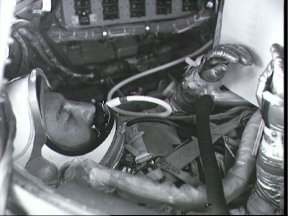Click on image for full size
Courtesy of NASA
Related links:
Sunken Mercury Capsule is Recovered!
News story originally written on July 21, 1999
A 38 year-old Mercury capsule has finally been found and recovered from the Atlantic Ocean. The Liberty Bell 7, an important piece of the Mercury Program, sank to the sea floor after successfully making its flight into space. This rusty, muddy U.S. spacecraft was the only one to have a successful mission and not be recovered.
The Liberty Bell 7 was flown by Gus Grissom in 1961. When the capsule landed in the ocean, the hatch blew open prematurely, allowing water to flow in. Grissom survived the accident, but the helicopter couldn't support the weight of the capsule. It spent the rest of its life on the ocean floor, until now.
"It was nerve-wracking," said Curt Newport, the leader of the salvage mission. "I have to sit back and try to take it all in when I get a chance."
Surprisingly, the spacecraft remained intact throughout the years. Even the cord used by the helicopter while trying to save the vessel was still attached. The capsule weighed almost 2 tons because it was full of so much mud. This made it difficult to bring up from 3 miles below the surface. Newport's team had to use a Kevlar line with three clamps to haul the Mercury craft onto the ship.
"It's one heck of a feat," Bill Smith, deputy director of NASA space access and exploration programs, said. "I think it's super. It brings the rest of the history of Mercury together and onshore."
Unfortunately, the hatch that was blown off could not be covered due to time constraints. Scientists were hoping to study the hatch to see why it opened early. Up until his death in 1967, Grissom insisted he was not at fault. Grissom died when a fire erupted aboard Apollo 1.
The capsule will now have a new home in the Kansas Cosmosphere and Space Center in Hutchinson, Kansas. The Discovery Channel paid Newport and his crew to recover the Liberty Bell 7, but it is still considered government property. The television station will take the capsule on a 3 year tour before it is permanently displayed at the museum.















